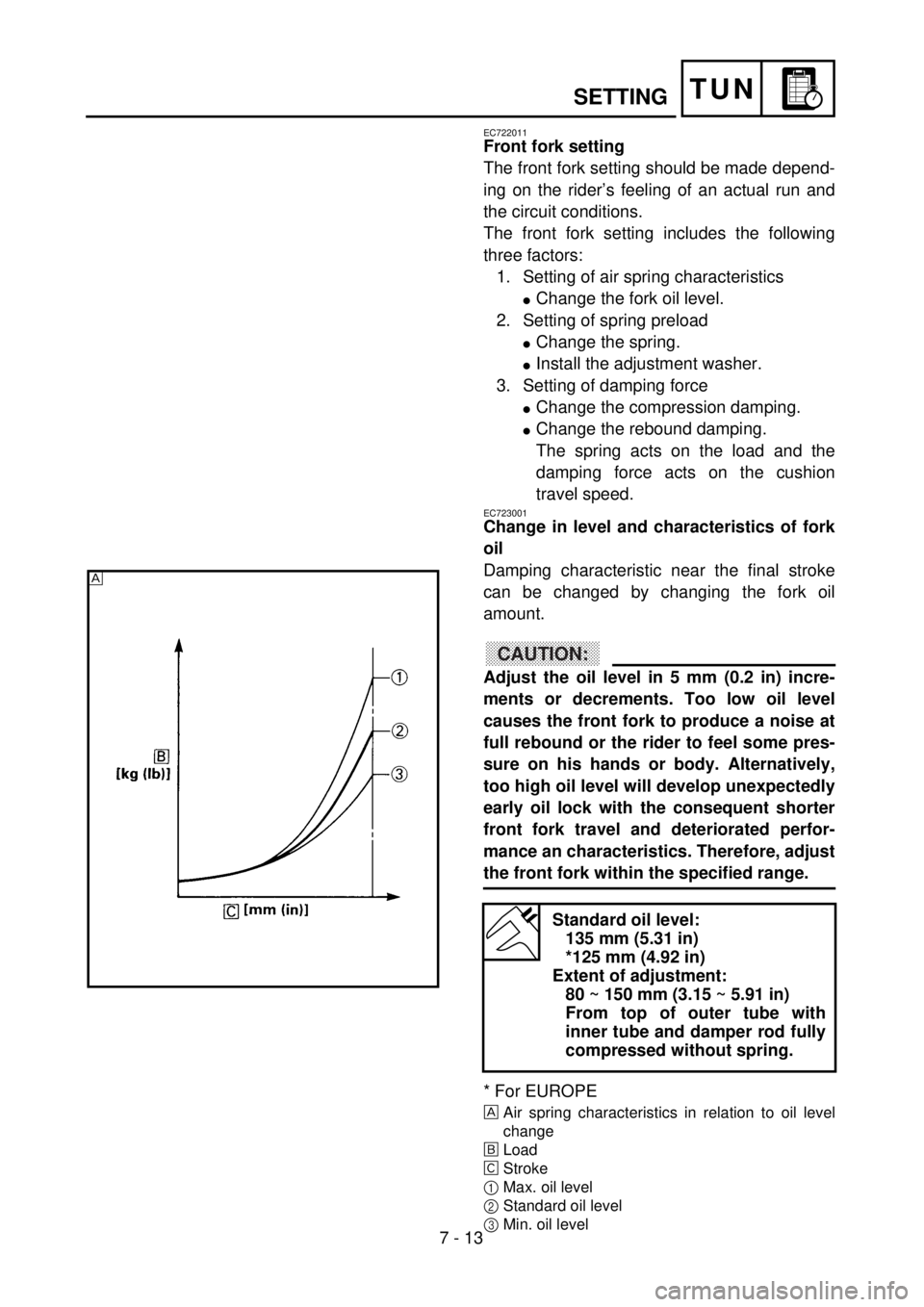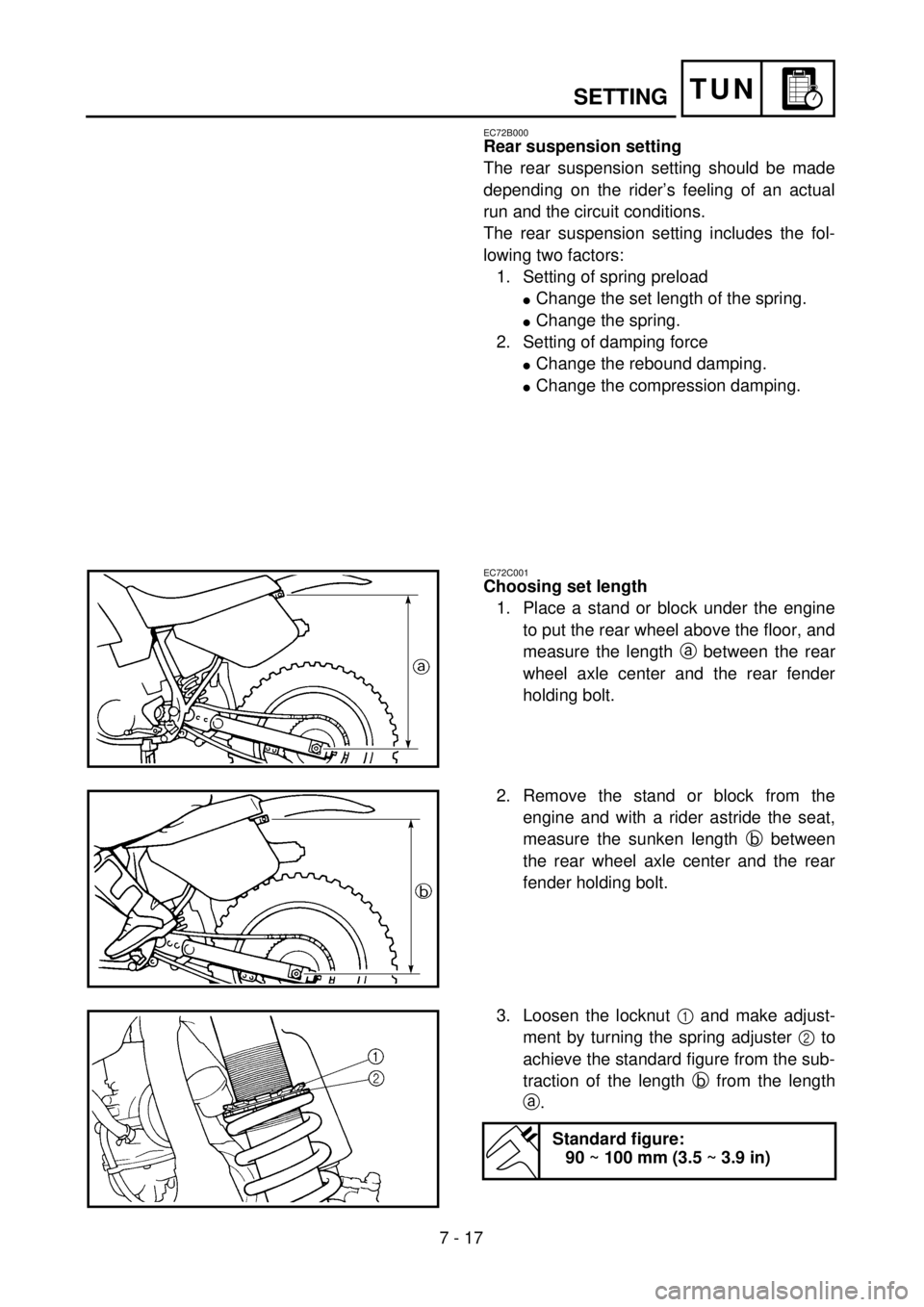lock YAMAHA WR 426F 2001 Notices Demploi (in French)
[x] Cancel search | Manufacturer: YAMAHA, Model Year: 2001, Model line: WR 426F, Model: YAMAHA WR 426F 2001Pages: 762, PDF Size: 62.36 MB
Page 689 of 762

–+ELEC
SYSTEME D’ALLUMAGE
ZÜNDANLAGE
SISTEMA DE ENCENDIDO
ZÜNDFUNKENSTRECKE KON-
TROLLIEREN
1. Den Zündkerzenstecker von
der Zündkerze abziehen.
2. Den Zündfunkenstreckente-
ster 1 (bzw. 2) wie abgebil-
det anschließen.
lZündkerzenstecker 3
lZündkerze 4
Nur USA und CDN
õNicht USA und CDN
3.Den Motor mit dem Kick-
starter durchdrehen
.
4. Die Zündfunkenstrecke kon-
trollieren.
5. Den Motor anlassen und die
Zündfunkenstrecke vergrö-
ßern, bis es zu Fehlzündun-
gen kommt (nur USA und
CDN).
Min. Zündfunkenstrecke
6,0 mm
STECKVERBINDER- UND KABEL-
ANSCHLÜSSE KONTROLLIEREN
1. Kontrollieren:
lSteckverbinder- und Kabel-
anschlüsse
Rost/Staub/Lockerheit/Kurz-
schluß ® Instand setzen
oder erneuern.
MOTORSTOPPSCHALTER “ENGI-
NE STOP” KONTROLLIEREN
1. Kontrollieren:
lMotorstoppschalter
(auf Durchgang)
Kein Durchgang bei gedrücktem
Schalter ® Erneuern.
Durchgang bei freigelassenem
Schalter ® Erneuern. Meßkabel (+) ®
Schwarz/Weiß Kabel 1
Meßkabel (–) ®
Schwarz Kabel 2
B/W
1 B
2 Meßge-
rät-
Einstel-
GE-
DRÜCKT
W ´ 1
FREI
TEST DE L’INTERVALLE D’ETIN-
CELLEMENT D’ALLUMAGE
1. Déconnecter le capuchon de bou-
gie de la bougie.
2. Connecter le testeur dynamique
d’étincelle 1 (testeur d’allu-
mage 2) comme indiqué.
lCapuchon de bougie 3
lBougie 4
Pour les USA et le CDN
õExcepté pour les USA et le CDN
3. Actionner le démarreur au pied.
4. Contrôler la longueur d’étincelle
d’allumage.
5. Démarrer le moteur et augmenter
la longueur d’étincelle jusqu’à ce
qu’un raté se produise. (unique-
ment USA et CDN)
Longueur d’étincelle mini-
mum:
6,0 mm (0,24 in)
CONTROLE DES CONNEXIONS
DE COUPLEURS ET FILS
1. Contrôler:
lConnexion de coupleurs et fils
Rouille/poussière/jeu/court-cir-
cuit ® Réparer ou changer.
CONTROLE DU BOUTON
D’ARRET DU MOTEUR “ENGINE
STOP”
1. Vérifier:
lContinuité du bouton d’arrêt du
moteur “ENGINE STOP”
Pas de continuité lorsque enfoncé ®
Changer.
Continuité lorsque relâché ® Changer. Fil (+) de multimètre ®
Fil noir/blanc 1
Fil (–) de multimètre ® Fil noir 2
B/W
1B
2Position de
sélecteur
du multi-
mètre
EN-
FONCE
W ´ 1
RE-
LACHE
6 - 4
PRUEBA DE LA SEPARACIÓN
ENTRE PUNTAS DE LA BUJÍA
1. Desconecte la tapa de puntas de la
bujía de la bujía misma.
2. Conecte el tester dinámico de la
bujía 1 (comprobador de encen-
dido 2) tal y como se muestra.
lTapa de la bujía 3
lBujía 4
Para USA y CDN
õExcepto USA y CDN
3. Accione el arrancador del pedal.
4. Compruebe la separación entre
puntas de la bujía de encendido.
5. Arranque el motor e incremente
la separación entre puntas de la
bujía hasta que deje de saltar la
chispa (solamente para USA y
CDN).
Separación entre puntas
mínima de la bujía:
6,0 mm (0,24 in)
INSPECCIÓN DE ACOPLADORES
Y CONEXIÓN DE CABLES
1. Comprobar:
lConexión de acopladores y
cables
Oxido/polvo/flojedad/cortocir-
cuito ® Reparar o reemplazar.
INSPECCIÓN DEL BOTÓN DE
PARADA DE MOTOR “ENGINE
STOP”
1. Inspeccionar:
lConducto del botón de parada
de motor “ENGINE STOP”
Sin continuidad mientras se mantiene
pulsado ® Reemplazar.
Con continuidad mientras se suelta ®
Reemplazar.Cable del tester (+) ®
Cable negro/blanco 1
Cable del tester (–) ®
Cable negro 2
B/W
1B
2Posición
del selec-
tor del tes-
ter
PULSAR
(PUSH
IN)
W ´ 1
LIBRE
Page 699 of 762

–+ELEC
INSPEKTION DER STECKVERBIN-
DUNGEN UND KABELANSCHLÜS-
SE
1. Prüfen:
lSteckverbindungen und Ka-
belanschlüsse
Rost/Staub/Lockerung/Kurz-
schluß ® Reparieren oder
austauschen.
INSPEKTION DER TPS-SPULE
1. Prüfen:
lWiderstand der TPS-Spule
Außerhalb des Sollwerts ®
Austauschen.
2. Lockerung:
lDrosselklappen-Anschlag-
schraube
HINWEIS:
Die Drosselklappen-Anschlag-
schraube herausdrehen, bis die
Drosselklappenwelle vollständig ge-
schlossen ist.Prüfgerätkabel (+) ®
Blaues Kabel 1
Prüfgerätkabel (–) ®
Schwarzes Kabel 2
TPS-Spu-
lenwider-
standPrüfgeräte-
instellung
4–6 kW
bei 20 ˚CkW ´ 1
3. Prüfen:
lRegelwiderstand der TPS-
Spule
Prüfen, ob sich der Wider-
stand erhöht, während der
geschlossene Gasdrehgriff
ganz aufgedreht wird.
Außerhalb des Sollwerts ®
Austauschen.
Prüfgerätkabel (+) ®
Gelbes Kabel 1
Prüfgerätkabel (–) ®
Schwarzes Kabel 2
TPS-Spulenwi-
derstandPrüfgerät-
einstel-
lung
Ganz
geschlo
ssenGanz
offen
kW ´ 1
0–2 kW
bei
20 ˚C4–6 kW
bei
20 ˚C
CONTROLE DES CONNEXIONS
DES COUPLEURS ET DES FILS
1. Vérifier:
lConnexion coupleurs et fils
Rouille/poussière/court-circuit
® Réparer ou remplacer.
CONTROLE DE LA BOBINE DE
TPS
1. Contrôler:
lRésistance de la bobine de TPS
Hors spécifications ® Rempla-
cer.
2. Serrer:
lVis d’arrêt d’accélérateur
N.B.:
Tourner la vis d’arrêt d’accélérateur
jusqu’à ce que l’axe de l’accélérateur
soit en position de fermeture complète.Fil (+) de multimètre ® Fil bleu 1
Fil (–) de multimètre ® Fil noir 2
Résistance
de la bobine
de TPS Position du
sélecteur de
multimètre
4 à 6 kW à
20 ˚C (68 ˚F)kW ´ 1
3. Contrôler:
lRésistance variable de la
bobine de TPS
S’assurer que la résistance aug-
mente lorsque la manette des
gaz est tournée de la position
de fermeture complète à la
position d’ouverture complète.
Hors spécifications ® Rempla-
cer.
Fil (+) de multimètre ®
Fil jaune 1
Fil (–) de multimètre ® Fil noir 2
Résistance
variable de la
bobine de TPS Position du
sélecteur de
multimètre
Ferme-
ture
complèteOuver-
ture
complète
kW ´ 1
0 à 2 kW
à 20 ˚C
(68 ˚F)4 à 6 kW
à 20 ˚C
(68 ˚F)
INSPECCIÓN DE LA CONEXIÓN
DE LOS CABLES Y LOS ACOPLA-
DORES
1. Inspeccionar:
lConexión de cables y acopla-
dores
Óxido/polvo/flojedad/cortocir-
cuito ® Reparar o reemplazar.
INSPECCIÓN DE LA BOBINA TPS
1. Inspeccionar:
lResistencia de la bobina TPS
Fuera de especificaciones ®
Reemplazar.
2. Aflojar:
lTornillo de parad del acelera-
dor
NOTA:
Gire hacia fuera el tornillo de parada del
acelerador hasta que el eje del acelerador
esté en la posición completamente
cerrado.Cable del tester (+) ®
Cable azul 1
Cable del tester (–) ®
Cable negro 2
Resistencia
de la bobina
TPS Posición del
selector del
tester
4 ~ 6 kW a
20 ˚C (68 ˚F)kW ´ 1
3. Inspeccionar:
lResistencia variable de la
bobina TPS
Compruebe que la resistencia
ha aumentado cuando haya
movido la empuñadura del ace-
lerador de la posición comple-
tamente cerrado a la posición
completamente abierto.
Fuera de especificaciones ®
Reemplazar.
Cable del tester (+) ®
Cable amarillo 1
Cable del tester (–) ®
Cable negro 2
Resistencia
variable de la
bobina TPSPosición
del selec-
tor del
tester
Comple-
tamente
cerradoComple-
tamente
abierto
kW ´ 1
0 ~ 2 kW
a 20 ˚C
(68 ˚F)4 ~ 6 kW
a 20 ˚C
(68 ˚F)
SYSTEME TPS (CAPTEUR DU PAPILLON D’ACCELERATION)
TPS-SYSTEM (DROSSELKLAPPEN-POSITIONSSENSOR)
SISTEMA TPS (SENSOR DE POSICIÓN DEL ACELERADOR)
6 - 8
Page 736 of 762

7 - 13
TUNSETTING
EC722011
Front fork setting
The front fork setting should be made depend-
ing on the rider’s feeling of an actual run and
the circuit conditions.
The front fork setting includes the following
three factors:
1. Setting of air spring characteristics
lChange the fork oil level.
2. Setting of spring preload
lChange the spring.
lInstall the adjustment washer.
3. Setting of damping force
lChange the compression damping.
lChange the rebound damping.
The spring acts on the load and the
damping force acts on the cushion
travel speed.
EC723001
Change in level and characteristics of fork
oil
Damping characteristic near the final stroke
can be changed by changing the fork oil
amount.
CAUTION:
Adjust the oil level in 5 mm (0.2 in) incre-
ments or decrements. Too low oil level
causes the front fork to produce a noise at
full rebound or the rider to feel some pres-
sure on his hands or body. Alternatively,
too high oil level will develop unexpectedly
early oil lock with the consequent shorter
front fork travel and deteriorated perfor-
mance an characteristics. Therefore, adjust
the front fork within the specified range.
* For EUROPE
Air spring characteristics in relation to oil level
change
õLoad
‚Stroke
1Max. oil level
2Standard oil level
3Min. oil level
Standard oil level:
135 mm (5.31 in)
*125 mm (4.92 in)
Extent of adjustment:
80 ~ 150 mm (3.15 ~ 5.91 in)
From top of outer tube with
inner tube and damper rod fully
compressed without spring.
Page 744 of 762

7 - 17
TUN
EC72B000
Rear suspension setting
The rear suspension setting should be made
depending on the rider’s feeling of an actual
run and the circuit conditions.
The rear suspension setting includes the fol-
lowing two factors:
1. Setting of spring preload
lChange the set length of the spring.
lChange the spring.
2. Setting of damping force
lChange the rebound damping.
lChange the compression damping.
EC72C001
Choosing set length
1. Place a stand or block under the engine
to put the rear wheel above the floor, and
measure the length a between the rear
wheel axle center and the rear fender
holding bolt.
2. Remove the stand or block from the
engine and with a rider astride the seat,
measure the sunken length b between
the rear wheel axle center and the rear
fender holding bolt.
3. Loosen the locknut 1 and make adjust-
ment by turning the spring adjuster 2 to
achieve the standard figure from the sub-
traction of the length b from the length
a.
Standard figure:
90 ~ 100 mm (3.5 ~ 3.9 in)
SETTING
Page 752 of 762

7 - 21
TUNSETTING
EC72H002
Suspension setting
lFront fork
NOTE:
lIf any of the following symptoms is experienced with the standard position as the base, make
resetting by reference to the adjustment procedure given in the same chart.
lBefore any change, set the rear shock absorber sunken length to the standard figure 90 ~
100 mm (3.5 ~ 3.9 in).
SymptomSection
Check Adjust
JumpLarge
gapMedium
gapSmall
gap
Stiff over entire range
CCC
Compression damping
Oil level (oil amount)
SpringTurn adjuster counterclockwise (about 2 clicks) to
decrease damping.
Decrease oil level by about 5 ~ 10 mm (0.2 ~ 0.4 in).
Replace with soft spring.
Unsmooth movement
over entire range
CCCC
Outer tube
Inner tube
Under bracket tightening
torqueCheck for any bends, dents, and other noticeable
scars, etc. If any, replace affected parts.
Retighten to specified torque.
Poor initial movement
C
Rebound damping
Oil sealTurn adjuster counterclockwise (about 2 clicks) to
decrease damping.
Apply grease in oil seal wall.
Soft over entire range,
bottoming out
CC
Compression damping
Oil level (oil amount)
SpringTurn adjuster clockwise (about 2 clicks) to increase
damping.
Increase oil level by about 5 ~ 10 mm (0.2 ~ 0.4 in).
Replace with stiff spring.
Stiff toward stroke end
COil level (oil amount) Decrease oil level by about 5 mm (0.2 in).
Soft toward stroke end,
bottoming out
COil level (oil amount) Increase oil level by about 5 mm (0.2 in).
Stiff initial movement
CCCCCompression dampingTurn adjuster counterclockwise (about 2 clicks) to
decrease damping.
Low front, tending to
lower front posture
CC
Compression damping
Rebound damping
Balance with rear end
Oil level (oil amount)Turn adjuster clockwise (about 2 clicks) to increase
damping.
Turn adjuster counterclockwise (about 2 clicks) to
decrease damping.
Set sunken length for 95 ~ 100 mm (3.7 ~ 3.9 in) when
one passenger is astride seat (lower rear posture).
Increase oil level by about 5 mm (0.2 in).
“Obtrusive” front, tend-
ing to upper front pos-
ture
CC
Compression damping
Balance with rear end
Spring
Oil lever (oil amount)Turn adjuster counterclockwise (about 2 clicks) to
decrease damping.
Set sunken length for 90 ~ 95 mm (3.5 ~ 3.7 in) when
one passenger is astride seat (upper rear posture).
Replace with soft spring.
Decrease oil level by about 5 ~ 10 mm (0.2 ~ 0.4 in).
Page 753 of 762

7 - 22
TUNSETTING
lRear shock absorber
NOTE:
lIf any of the following symptoms is experienced with the standard position as the base, make
resetting by reference to the adjustment procedure given in the same chart.
lAdjust the rebound damping in 2-click increments or decrements.
lAdjust the low compression damping in 1-click increments or decrements.
lAdjust the high compression damping in 1/6 turn increments or decrements.
SymptomSection
Check Adjust
JumpLarge
gapMedium
gapSmall
gap
Stiff, tending to sink
CC
Rebound damping
Spring set lengthTurn adjuster counterclockwise (about 2 clicks) to
decrease damping.
Set sunken length for 90 ~ 100 mm (3.5 ~ 3.9 in) when
one passenger is astride seat.
Spongy and unstable
CC
Rebound damping
Low compression damping
SpringTurn adjuster clockwise (about 2 clicks) to increase
damping.
Turn adjuster clockwise (about 1 clicks) to increase
damping.
Replace with stiff spring.
Heavy and dragging
CC
Rebound damping
SpringTurn adjuster counterclockwise (about 2 clicks) to
decrease damping.
Replace with soft spring.
Poor road gripping
C
Rebound damping
Low compression damping
High compression damp-
ing
Spring set length
SpringTurn adjuster counterclockwise (about 2 clicks) to
decrease damping.
Turn adjuster clockwise (about 1 clicks) to increase
damping.
Turn adjuster clockwise (about 1/6 clicks) to increase
damping.
Set sunken length for 90 ~ 100 mm (3.5 ~ 3.9 in) when
one passenger is astride seat.
Replace with soft spring.
Bottoming out
CC
High compression damp-
ing
Spring set length
SpringTurn adjuster clockwise (about 1/6 turn) to increase
damping.
Set sunken length for 90 ~ 100 mm (3.5 ~ 3.9 in) when
one passenger in astride seat.
Replace with stiff spring.
Bouncing
CC
Rebound damping
SpringTurn adjuster clockwise (about 2 clicks) to increase
damping.
Replace with soft spring.
Stiff travel
CC
High compression damp-
ing
Spring set length
SpringTurn adjuster counterclockwise (about 1/6 turn) to
decrease damping.
Set sunken length for 95 ~ 100 mm (3.7 ~ 3.9 in) when
one passenger is astride seat.
Replace with soft spring.